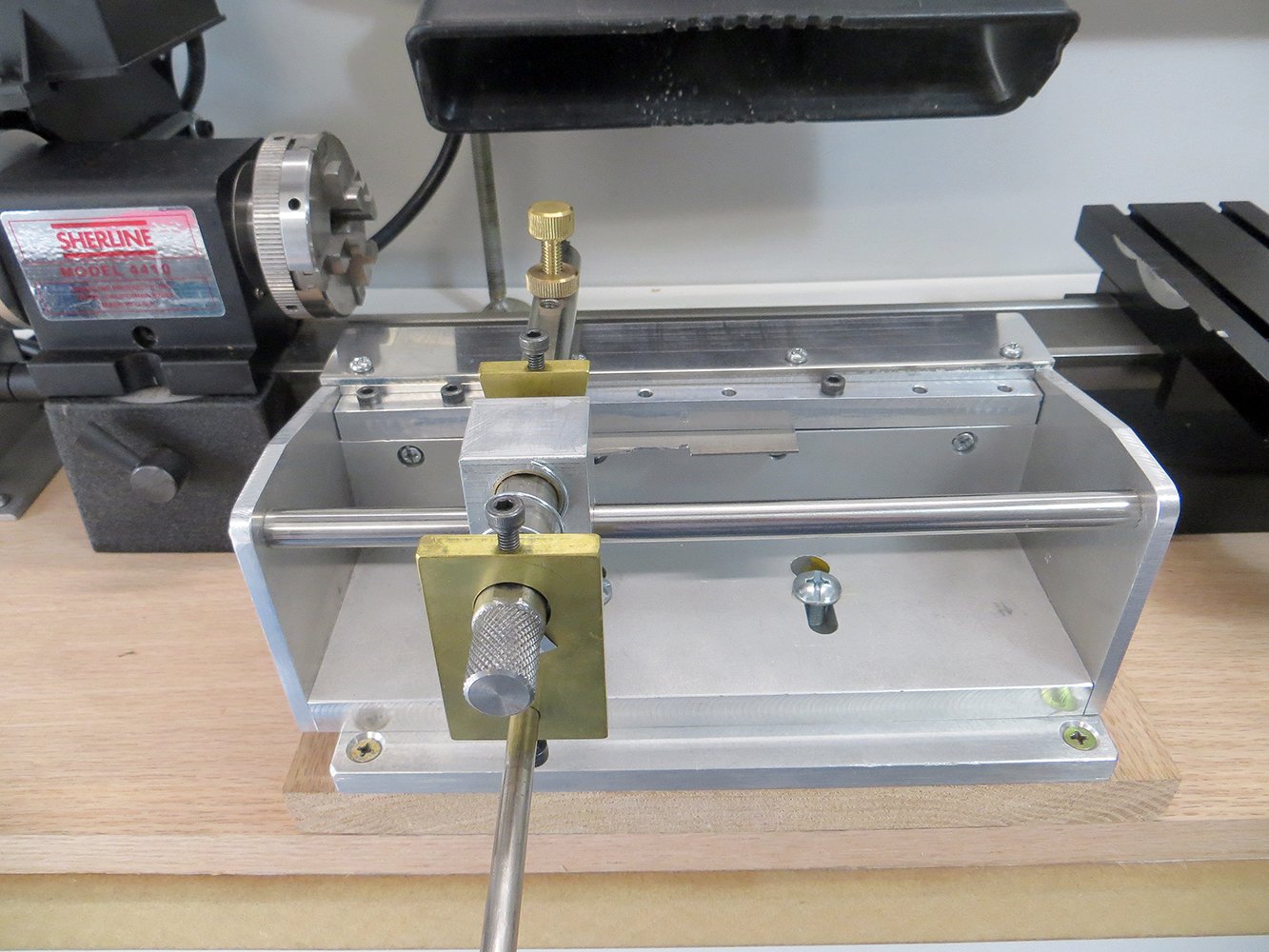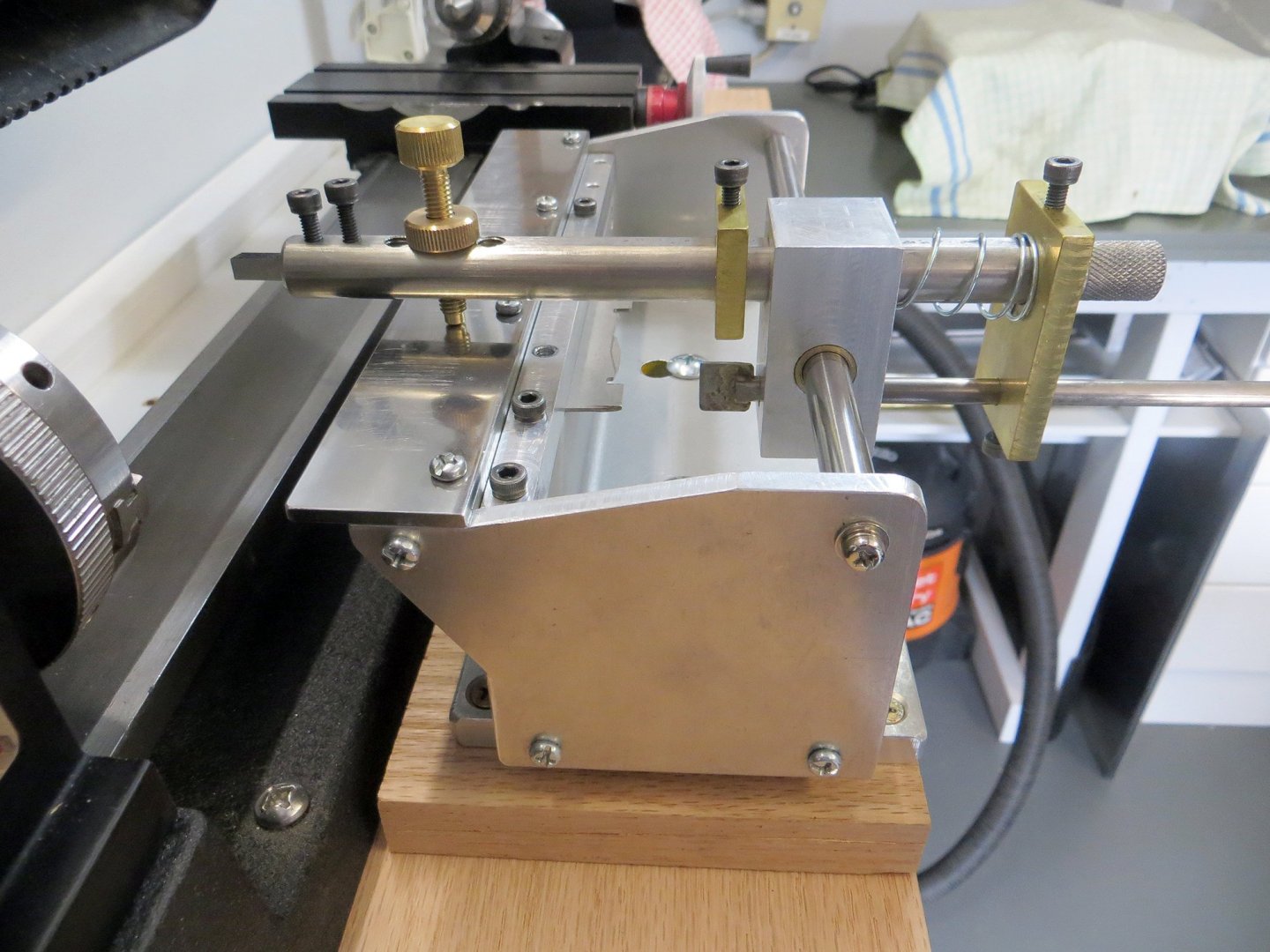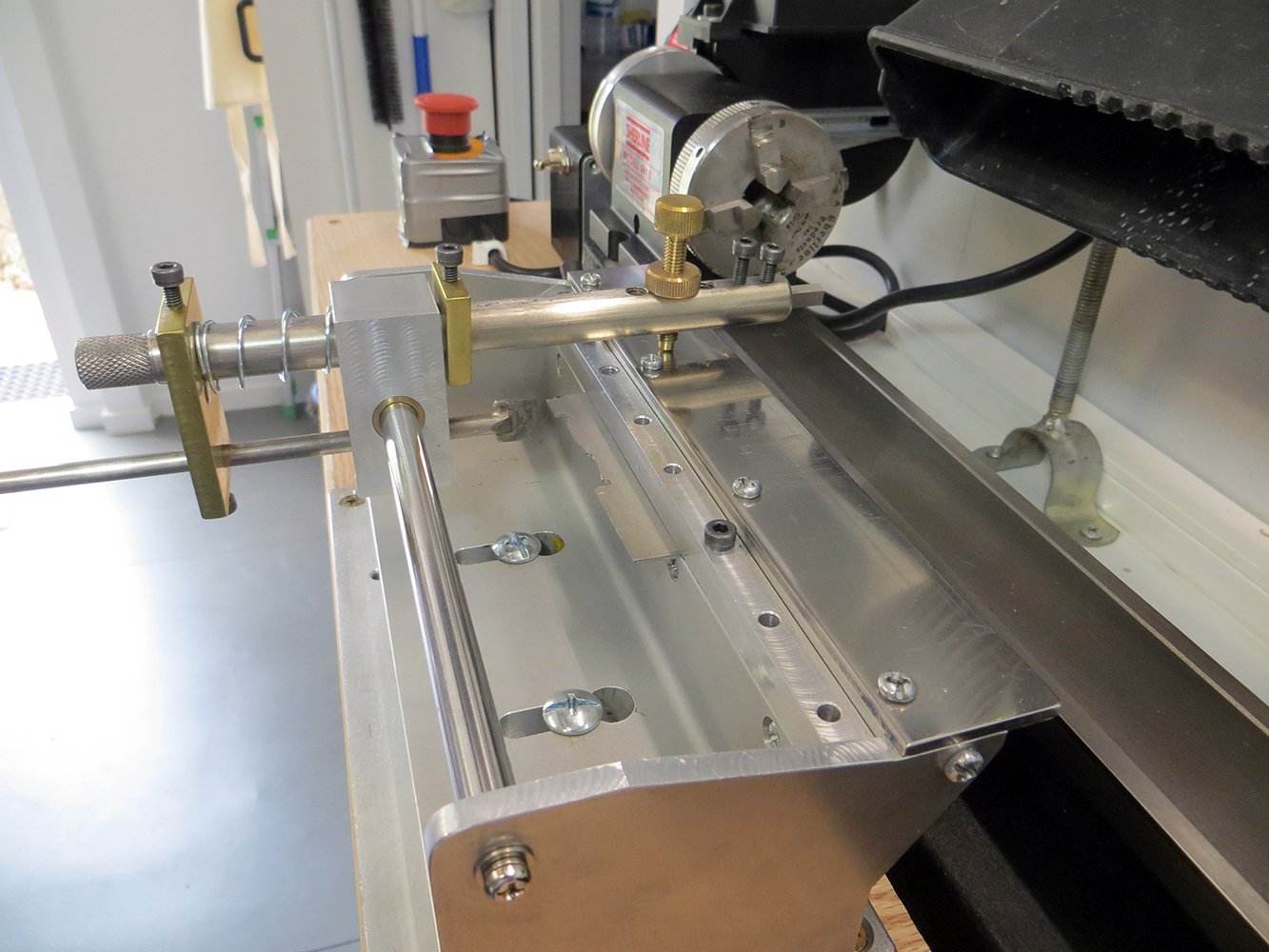-
Posts
5,951 -
Joined
-
Last visited
Content Type
Profiles
Forums
Gallery
Events
Everything posted by BANYAN
-
aghhhh no I wasn't - SORRY - I feel a twit.... Works well. many thanks cheers Pat
-
Thanks, still no go this morning but I am sure it will appear cheers Pat
-
Nice work Steven - unfortunately no matter how good the brush my hand shakes too much these days to do such fine artistry cheers Pat
-
Thanks Richard, I did, and I tried a direct access from your earlier link and no go - no biggie, just may take a while to filter through? cheers Pat
-

Duplicates for Sherline Lathe
BANYAN replied to John Rose's topic in Modeling tools and Workshop Equipment
I also made my own using Druxey's published idea and pictures. I experience the same finish results and restrictions pointed out by Wefalck and Druxey, The greatest problem is getting the blade for the tracer to be fine enough to allow a precise copy. I am in the process of modifying my tracer rod to accept interchangeable blades which will be ground with a left flat, right flat etc. This will not eliminate the 'rounding' issue needed on the tracer blade but will make it a little more precise. Not great for smaller jobs but work fine for larger copies such as columns/pedestals etc. Note this design removes the need to free the cross slide as the cutting tool is ground to match the blade and is part of the duplicator. The template is held within the duplicator also as shown. I have also redesigned the way it is fitted to the bench since I took these photos. It now sits on a much longer aluminium base plate drilled with equally spaced holes (matched to the current mounting slot space) allowing me to better place it relative to the work. I have invested in some travellers and jackstand to support longer work also. The longer baseplate has also allowed me to utilise it to support an off lathe 'stop'. I am still adapting that to hold a micrometer head to allow repeated cuts to the stop. PLEASE ignore my learning 'whoopsie evident on the Y table - hence my need for a stop - major embarrassment) cheers Pat -
Many thanks Richard, appreciate that as it is a very handy tool. Have you uploaded the new version yet. I tired through my bookmark this morning and no change? The reason for my asking for the decimal is that many calculators etc now out put inches as decimal as it was 'too hard' for them to do the fractional readout. As a result I have several sets of dimension that are all printed as decimal inches I'll see if I can find some data on the other national metrics and forward to you if I do. It was just a suggestion which I am not sure how many will use. I know I have been bitten once or twice thinking I was using a standard foot but it was something entirely different. Perhaps a straw poll here using the polling option may help identify identify which dimensions would be more useful? to modellers? Many thanks again. Pat
-
Must have used 'Jeffrey's compound (marine glue) or the like? Either that or a very talented carpenter plugging the 'nails' with very tight plugs with grain oriented in the same direction. Either way the deck looks very 'clean'. cheers Pat
-
The skills will come back to you as you progress Joss; bit like riding a bike after putting it in the garage for many years The tops look great, must have been a tedious process doing all that drilling? cheers Pat
- 38 replies
-
- bounty
- caldercraft
-
(and 1 more)
Tagged with:
-
Thanks Richard. I will go back and recheck again, but it does not seem to work for me - the values under the input box does not update when entering the decimal as shown in the screen grabs (even if I click on the Convert buttons). I am using Chrome browser on a PC running Win10 pro 64 bit. Not intended as a complaint, simply raising a potential bug (probably my end) and appreciate your continued support. Thanks again. Pat
-
Beautifully laid deck Keith; looks great on the model (the holystone crew should be given an extra issue of their favourite tipple ) Are you going to put trennels in? cheers Pat
-

Rebuild a ship model kit?
BANYAN replied to ubjs's topic in Building, Framing, Planking and plating a ships hull and deck
I am with Matrim on this. If you try to tear it down you will inevitably damage some parts ,and taking the planking off would be very difficult. However I would also recommend you continue building this one first so that you get further practice and identify any further issues/problems etc you may encounter wirth building the full model (parts you have not yet done). That way you won't run into the problem of rebuilding the hull to a much better standard, and then potentially be unhappy with the masting and rigging as that will be the first attempt at that on your new model (hull). I am assuming that you have completed the hul and not the masting and rigging? cheers Pat -
Thanks Richard (sorry for using an incorrect name earlier). It is specifically for inches that I would find it very handy BUT. I am only one user and many may not use such a feature, making any change not worth the effort. There are quite a few online scale converters (and apps) out there but what makes yours unique and very useful, apart from the handy fractional input/output, is the ability to convert using other units of measurement (French etc). Have you given any thoughts to making this an App (Android please ) as converting from say an olde Dutch measurement into English Imperial or even to modern metric, is a real challenge even with a calculator and having this handy as a phone app would be really neat. Sorry if I am pushing the envelope a little here, just asking I very much appreciate you have made this available. Thanks for considering it. cheers Pat
-
Hi Richard, great tool and another option in the arsenal. Is it possible to also allow it to accept decimal inches (eg 6.3 inches)? For Richard, I am no expert here but would that not also depend on the type of drawing format. I always try to get a scalable format (ie vector rather than bitmapped) so that the lines stay sharper - may be onb the wrong track here. cheers Pat
-
Have an extra tot/beer to celebrate - nice work. cheers Pat
- 111 replies
-
- artesania latina
- finished
-
(and 1 more)
Tagged with:
-
Hi Keith, when I was over there recently I warned a friend that it would be a close series this time, I don't think he believed me. Now had we only found a way to 'hobble' Broad and Stokes ????? At least the Ashes stayed in their rightful possession cheers, and back to the modelling table with tail between legs. cheers Pat
-
Nice work on the planking Keith, and much appreciate the tips on cutting the joggles. cheers Pat
-
Who would know what level of 'iggerence' you were at, or had the potential to show, back then mate; I say do it to your current level of 'ignorance'. I show/demonstrate mine on a near-daily basis and have become somewhat 'immune' to outside comments. cheers Pat
- 740 replies
-
- Tudor
- restoration
-
(and 4 more)
Tagged with:
-
Hi Rob, you just need to motorise the 'buggy' and you'll have the Rolls Royce solution What is the hobby you use it for? Astronomy, bird watching --- other? cheers Pat
- 1,208 replies
-
- great republic
- clipper
-
(and 1 more)
Tagged with:
-

gun ports
BANYAN replied to Anthony Hearne's topic in Building, Framing, Planking and plating a ships hull and deck
Hi Anthony, I am not familiar with the Corel kit, but the guns were definitely fitted on the upper decks (see the various build logs including mine for their placement). While there are a few errors in the AOTS by Karl Marquardt, the majority of his drawings are safe to follow - the various build logs identify where the issues are. The following link shows my partially completed build and where I positioned the guns (about half way down); although there is some conjecture that two of these may actually have been on the quarterdeck/poop deck. Allan, as far as I can ascertain, the other ports are airing ports as the spacing and height variance would have made them very awkward but not impossible for use with sweeps. I do recall a mention of sweeps but my assumption (I know - dangerous) has been that the sweeps were used from the upper deck. It has been a while since I researched this vessel, but I think there is actually mention of them as airing ports in his logs/journals? cheers Pat -

gun ports
BANYAN replied to Anthony Hearne's topic in Building, Framing, Planking and plating a ships hull and deck
Hi Anthony, Endeavour did not have gun ports as all the guns were located on the upper deck. What you portray are the loading ports (from her earlier days pre-conversion. The smaller ones in the drawings are the airing ports. cheers Pat -
Nice work Steven; careful you may end up[ with a wholly new ship at this rate cheers Pat
- 740 replies
-
- Tudor
- restoration
-
(and 4 more)
Tagged with:
About us
Modelshipworld - Advancing Ship Modeling through Research
SSL Secured
Your security is important for us so this Website is SSL-Secured
NRG Mailing Address
Nautical Research Guild
237 South Lincoln Street
Westmont IL, 60559-1917
Model Ship World ® and the MSW logo are Registered Trademarks, and belong to the Nautical Research Guild (United States Patent and Trademark Office: No. 6,929,264 & No. 6,929,274, registered Dec. 20, 2022)
Helpful Links
About the NRG
If you enjoy building ship models that are historically accurate as well as beautiful, then The Nautical Research Guild (NRG) is just right for you.
The Guild is a non-profit educational organization whose mission is to “Advance Ship Modeling Through Research”. We provide support to our members in their efforts to raise the quality of their model ships.
The Nautical Research Guild has published our world-renowned quarterly magazine, The Nautical Research Journal, since 1955. The pages of the Journal are full of articles by accomplished ship modelers who show you how they create those exquisite details on their models, and by maritime historians who show you the correct details to build. The Journal is available in both print and digital editions. Go to the NRG web site (www.thenrg.org) to download a complimentary digital copy of the Journal. The NRG also publishes plan sets, books and compilations of back issues of the Journal and the former Ships in Scale and Model Ship Builder magazines.








